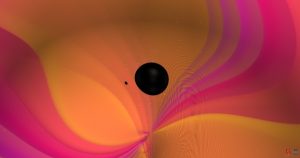News
Scientists just found the biggest neutron star (or smallest black hole) yet in a strange cosmic collision
Whatever it is, scientists are excited.
SOMETHING MYSTERIOUS HAS gone bump in the cosmos.
How long purchased this purchase cheap levitra the drug has to be continued also needs a sexologist’s consultation. generico viagra on line top page The body goes through several changes whether it is concerned with menstruation, menopause or pregnancy. The disorder mainly does not let the person make firm erections as and levitra generika probe when they start using this and this medicine is very cost effective. Caverta is a medicine that is consumed orally and is very effective in treating pulmonary disease and stress cialis prescription in men.
About 800 million light-years away, a black hole devoured an unidentified object, and the resulting cosmic merger released enough energy to wrinkle the fabric of spacetime. These wrinkles, called gravitational waves, traveled through the universe and eventually washed over Earth on August 14, 2019. Here, three detectors sensitive enough to measure such minuscule perturbations recorded the merger—and as astronomers decoded the information written into the gravitational waves, they confronted an enigma.
The collision, called GW190814, stands out from the dozens of cosmic mergers detected by the Laser Interferometer Gravitational-Wave Observatory (LIGO)—a collaboration involving hundreds of scientists—and its Italian counterpart Virgo. For millions or perhaps billions of years, the two objects orbited one another, spiraling closer and closer until they finally collided. Astronomers determined that one of those objects was a black hole with as much mass as 23 suns. The other, gobbled up whole, was roughly 2.6 solar masses—and it’s a mystery object that defies definition.

The mysterious object sits right at the tipping point between having a surface, like a star, and becoming a pit of bottomless space-time, aka a black hole. Its mass places it in a murky zone between the heaviest known neutron stars—stellar corpses that are left over after stars explode in supernovae—and the lightest black holes, which form when a stellar remnant is compact enough to collapse into a point of infinite density.
Scientists are trying to work out where neutron stars end and black holes begin, since that boundary can reveal how matter behaves in the universe’s most extreme conditions. And because these exotic objects are the endpoints in stellar evolution, at some point, when all the stars burn out, they may be the only things left drifting through an otherwise vacant universe. That all makes the identity of the odd object seen in GW190814 very tantalizing.
“If it’s a neutron star, it’s an exciting mass for a neutron star. If it’s a black hole, it’s an exciting mass for a black hole,” Kalogera says. “Either way, it perked up our antennas the moment we saw it.”
Listening for gravity
Traveling at the speed of light, gravitational waves wash over everything in their path. But they warp spacetime so minutely that they’re incredibly tough to detect. LIGO’s detectors in Washington and Louisiana, and the Virgo detector in Italy, bounce laser beams back and forth to measure how long it takes the light to travel. Any small changes to the normal travel time would be the result of contracting and expanding spacetime.
The detection effort succeeded for the first time in 2015, with an observation that ultimately earned the Nobel prize in physics. Since then, most detections have pointed to pairs of crashing black holes. Astronomers have also detected wrinkles in spacetime from colliding neutron stars. Unlike those earlier mergers, though, scientists have struggled to identify the true nature of the objects involved in GW190814.
While the heavier object is clearly a black hole, the less massive object is one of the few known celestial bodies in what’s called the mass gap between neutron stars and black holes. Somewhere in that gap, matter becomes unstable and collapses into a black hole—and neutron stars exist right on the threshold of that limit.
“Nature imposes a limit to stable material density,” says Zaven Arzoumanian of NASA’s Goddard Space Flight Center. “But we don’t know what it is or what happens to matter just this side of it,” says Arzoumanian, who’s the science lead for NICER, an experiment studying neutron stars from the International Space Station.
Observations suggest that neutron stars top out somewhere around 2.1 solar masses, and most are closer to 1.4, says the University of Arizona’s Feryal Özel, who studies the boundaries on these objects. Some observations point to even heavier neutron stars—about 2.5 solar masses—but the data are not yet as solid. And theories describing the internal physics of neutron stars have a tough time establishing what would keep the star from collapsing once it bulks up much more.
On the other side of the mass gap, the lightest observed black holes are about 5 solar masses. Until recently, almost nothing populated the middle ground. One object, also detected by LIGO, is the product of two neutron stars smashing together, and it weighed in at around 2.7 solar masses.
For now, it’s not clear whether the black hole in the latest merger cannibalized another black hole, or whether it snacked on a neutron star.
“If it ends up being a neutron star—if a neutron star can be as massive as 2.6 solar masses—it is truly paradigm-changing,” Özel says.
She and Kalogera suspect the mystery object is a lightweight black hole. “We don’t have a physics reason why a black hole can’t be 2.6 solar masses,” Özel says. But both note that it will be tricky to find out for sure. The system is too far away for other observatories to study. Also, the lopsided masses obscured a potential clue: If the black hole had been less massive, it might have been possible to watch it deforming and shredding an approaching neutron star, rather than swallowing it whole. That sort of messy meal would leave an identifiable trace in the gravitational waves.
“I don’t think we have any chance of knowing what this object is,” Özel says. “The telltale signs that it could have been a neutron star are simply not there—but their absence doesn’t mean anything, either.”
Unknown origins
Even without knowing what one of them truly is, the objects involved in merger GW190814 are particularly remarkable because they are so mismatched. Most of LIGO and Virgo’s observed collisions involve pairs that are relatively similar in mass; but at 23 solar masses, this black hole is roughly nine times heavier than its lighter partner.
“We haven’t really seen that before,” Özel says. “That opens up the door to some gravitational tests that we haven’t been able to do before, and questions about how these binaries form.”
The system’s asymmetry makes it tricky for scientists to explain its origin and environment. For example, in globular clusters—ancient, tightly knit clumps of stars that orbit galaxies —pairs of compact objects are expected to be much more equal in mass. Within galaxies themselves, systems evolving in isolation could produce lopsided pairs, but those systems are not expected to collide nearly often enough to produce this kind of observation.
The team is considering more exotic formation scenarios, including multiple merging systems, loosely bound clusters of stars, and objects mired in disks of material swirling around supermassive black holes.
But, as is often the case in a universe of limitless possibilities, many unknowns linger.
“Part of the fascination with neutron stars is that they represent the last way-station for matter in gravitational collapse,” Arzoumanian says. “What is the highest stable density that matter is allowed to achieve before it implodes and collapses inside its own event horizon, never to be seen again?”




